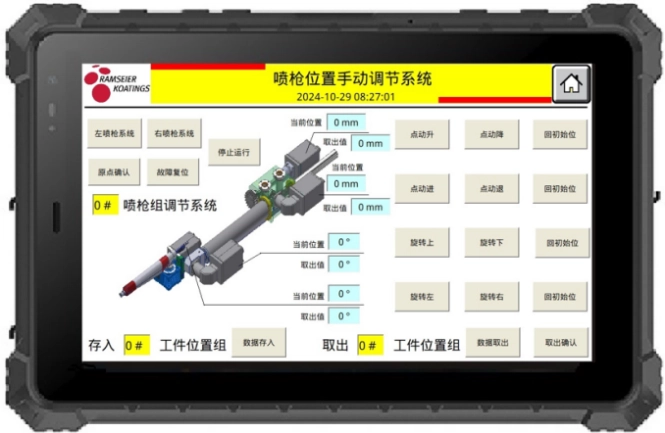Content Menu
● Understanding the foundations of powder coating data
● The economics of a smart platform: cost considerations
● Value drivers: quality, efficiency, and visibility
● Data quality as a foundation for value
● Implementation strategies: phased vs big-bang approaches
● Change management: getting people onboard
● Data architecture and integration considerations
● Quality control enhanced by analytics
● Sustainability and waste reduction
● Security and compliance considerations
● Vendor selection and procurement guidance
● Workforce development: empowering operators
● Measuring success: defining KPIs and outcomes
● Potential challenges and mitigation
● The strategic horizon: what the future holds
● Practical steps to begin your upgrade journey
● Frequently asked questions
● Conclusion
● Related Questions and Answers
In the metal finishing industry, powder coating stands as a reliable, high-quality finish that protects, beautifies, and extends the lifespan of products. Yet as competition intensifies and quality expectations rise, many shops find themselves at a crossroads: continue using legacy data practices or upgrade to a smart powder coating data platform. This transition is not merely a technology choice; it reflects a shift in how a business plans, executes, and optimizes its entire coating workflow. The decision hinges on balancing upfront costs against the long-term value generated by improved accuracy, consistency, and operational insight.

Understanding the foundations of powder coating data
To appreciate the potential impact of a smart data platform, it helps to delineate what data typically drives powder coating operations. Core datasets include material specifications, process parameters (temperature, time, spray settings), environmental readings (humidity, air flow, booth conditions), cure validation results, quality inspections, and traceability records. Traditionally, much of this information exists in disparate systems or paper records, creating silos, manual rework, and slow response to process shifts.
A modern, intelligent data platform consolidates these datasets into a unified, accessible repository. It enables real-time monitoring, automated data capture from sensors and controllers, and sophisticated analytics that surface actionable insights. The result is a more transparent, responsive, and consistent coating process.
The economics of a smart platform: cost considerations
Investing in a smart powder coating data platform involves several cost dimensions. While each facility has unique needs, the major budget lines typically include:
- Initial software licensing and implementation
- Hardware and sensors to enable data capture
- System integration with existing ERP, MES, or inventory systems
- Training for operators and supervisors
- Ongoing maintenance, updates, and potential cloud hosting charges
- Cybersecurity and data governance measures
Despite these upfront costs, the long-term financial picture often leans toward favorable return on investment. Key drivers of value include reduced scrap and rework, improved first-pass yield, accelerated setup times, and more precise powder consumption planning. Additionally, consistent quality reduces warranty exposure and strengthens customer satisfaction, which can translate into repeat business and better pricing power.
Value drivers: quality, efficiency, and visibility
A smart data platform unlocks value across several dimensions:
- Process stability and repeatability
- Real-time anomaly detection and alerting
- Predictive maintenance of equipment and components
- Accurate powder usage forecasting and waste reduction
- Comprehensive traceability for compliance and audits
- Data-driven continuous improvement programs
With clean data and robust analytics, teams can identify root causes of defects, optimize cure cycles, and tailor processes to different material batches or color codes. The visibility to track variations over time empowers better decision making at the plant floor and at the management level.
Data quality as a foundation for value
The adage “garbage in, garbage out” applies with vigor to powder coating data. A smart platform promises to improve data quality through standardized data models, automated capture, and validation rules. However, the platform's success depends on disciplined data governance, consistent measurement practices, and stakeholder engagement. Establishing data stewardship roles, defining key performance indicators, and setting up audit trails are essential steps in the journey.
Implementation strategies: phased vs big-bang approaches
Organizations often debate whether to migrate gradually or to execute a single, comprehensive deployment. Both strategies have merits and risks.
- Phased approach: Start with core capabilities such as real-time process monitoring and basic reporting, then incrementally add modules like predictive analytics, color management, and advanced traceability. This minimizes disruption and allows teams to learn and adapt.
- Big-bang approach: Roll out the full platform across facilities or lines, aiming for rapid value realization. While this can accelerate benefits, it requires meticulous project management, strong executive sponsorship, and a robust change management plan to minimize disruption.
A hybrid approach—pilot projects in select lines or plants followed by broader rollout—often balances speed and risk effectively.
Change management: getting people onboard
Technology alone rarely delivers maximum value without people embracing it. Change management should address:
- Clear articulation of benefits to operators, supervisors, and executives
- Hands-on training and ongoing coaching
- User-friendly dashboards tailored to different roles
- Incentives that align with data-driven goals
- Transparent communication about data ownership and privacy
When users see the platform as a tool that simplifies their work rather than a control mechanism, adoption accelerates, and the organization reaps more rapid gains.
Data architecture and integration considerations
A successful platform rests on a solid data architecture. Core design choices include:
- Data model alignment: ensuring that powder, batch, cure, color, and test data share common identifiers
- Real-time vs batch processing: choosing appropriate data ingestion rates for sensors and control systems
- Data storage strategy: on-premises, cloud, or hybrid, considering latency, security, and cost
- API-first integration: enabling seamless connections to MES, ERP, and reporting tools
- Data governance: defining data ownership, retention policies, access controls, and auditability
Interfacing with legacy equipment often requires edge devices or adapters to capture process parameters without disrupting operations. A flexible architecture reduces integration friction and future-proofs the investment.
Quality control enhanced by analytics
Smart platforms enable more rigorous and proactive quality control. Advanced analytics can correlate coating thickness, adhesion, cure temperature, and environmental conditions with final appearance and performance. With this insight, technicians can adjust recipes on the fly, select appropriate powder batches, and preemptively flag lines or equipment for maintenance before quality deteriorates.
Sustainability and waste reduction
Powder coating is already a material-efficient process, but a data-driven approach can lift sustainability further. By tightening control of powder usage, reducing overspray, and optimizing cure energy, facilities can lower emissions, energy consumption, and waste disposal costs. Transparent reporting supports sustainability commitments and helps meet regulatory or customer-specified environmental standards.
Security and compliance considerations
As data becomes a strategic asset, security and compliance rise in importance. Organizations should implement robust cybersecurity practices, including vulnerability management, encryption for data at rest and in transit, access controls, and regular security audits. Compliance frameworks relevant to manufacturing and quality management should be mapped to platform features, with clear documentation and traceability.
Vendor selection and procurement guidance
Choosing a smart powder coating data platform requires evaluating multiple vendors and configurations. Consider these factors:
- Alignment with existing workflows and systems
- Scalability to support future growth or additional lines
- Depth and usability of analytics and reporting
- Qualitative benefits such as improved collaboration and faster decision making
- Total cost of ownership beyond first-year licensing
- Track record in similar industries and customer references
- Roadmap for feature enhancements and regulatory compliance
Conduct proof-of-concept pilots to validate critical use cases, such as real-time process control, color management, or batch traceability, before committing to a full deployment.
Workforce development: empowering operators
A smart platform shifts some responsibilities toward data-driven decision making. Operators become guardians of data quality, early detectors of process deviations, and frontline contributors to continuous improvement. Providing hands-on training, intuitive dashboards, and clear escalation paths ensures operators feel empowered rather than overwhelmed.
Measuring success: defining KPIs and outcomes
To determine whether upgrading to a smart powder coating data platform is delivering value, establish clear key performance indicators. Common measures include:
- First-pass yield and scrap rate
- Changeover time and setup duration
- Powder usage per square meter or part
- Energy consumption per batch
- Tooling and maintenance costs per line
- On-time delivery and defect rate
- Traceability coverage and data completeness
Regular review cycles and executive dashboards help keep the project aligned with strategic objectives.
Potential challenges and mitigation
No upgrade is without risk. Common hurdles include data silos, resistance to change, downtime during migration, and the complexity of aligning multiple plant sites. Proactive mitigation involves early executive sponsorship, a pragmatic rollout plan, comprehensive training, and ongoing support. Clear communication about milestones, benefits, and responsibilities reduces uncertainty and builds momentum.
The strategic horizon: what the future holds
As smart powder coating platforms mature, they are likely to become more autonomous and interconnected with broader manufacturing ecosystems. Enhanced sensor networks, AI-driven optimization, and seamless integration with supply chain systems will enable even tighter feedback loops, more adaptive production lines, and greater resilience against volatility in demand or supply.
Practical steps to begin your upgrade journey
If you are ready to explore upgrading to a smart powder coating data platform, here is a practical starter plan:
- Map current data flows and identify critical gaps in visibility
- Define top-priority use cases that deliver measurable value
- Assemble a cross-functional implementation team with clear roles
- Run a small-scale pilot to validate data capture, analytics, and user adoption
- Develop a phased rollout plan with milestones and success criteria
- Invest in training, change management, and user support
- Establish data governance policies and security measures
- Monitor outcomes and iterate based on feedback and results
Frequently asked questions
What is a smart powder coating data platform? A smart platform integrates data from sensors, controllers, and management systems to provide real-time monitoring, analytics, and advanced insights for decision making and process optimization.
How does data quality affect coating outcomes? High-quality data enables accurate diagnostics, reproducible processes, and reliable traceability, which together reduce defects and waste.
What are common return-on-investment drivers for this upgrade? Key drivers include reduced scrap and rework, shorter setup times, better powder utilization, lower energy usage, and improved customer satisfaction.
How long does an implementation typically take? Timelines vary with scope, but phased deployments can begin delivering measurable benefits within months, with full value realized over one to two years depending on scale.
What are typical risks, and how can they be mitigated? Risks include integration challenges, user adoption gaps, and data governance gaps. Mitigation involves executive sponsorship, careful planning, targeted training, and ongoing support.

Conclusion
Upgrading to a smart powder coating data platform represents a strategic shift from reactive data handling to proactive, data-driven optimization. The upfront costs are offset by gains in quality stability, operational efficiency, and traceability, which collectively improve competitiveness and long-term profitability. By approaching the transition with a clear plan, strong governance, and a focus on people as much as technology, manufacturers can unlock a durable, scalable path to excellence in powder coating operations.
Related Questions and Answers
- What preparations are needed before launching a platform upgrade?
- How can I prioritize the highest-priority use cases for quick returns?
- What aspects should I focus on when implementing data governance?
- What are the pros and cons of cloud versus on-premises deployments?
- How can I evaluate the cost-effectiveness of different vendors?
Hot Tags: China, Global, OEM, private label, manufacturers, factory, suppliers, manufacturing company










































 .
. 